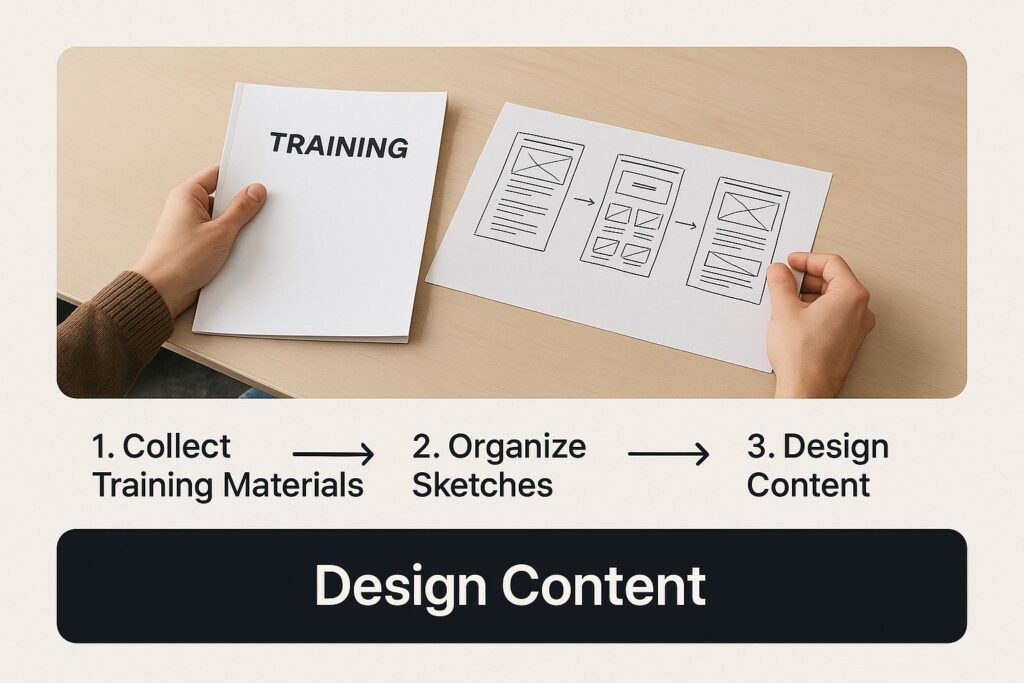Creating a Training Program That Actually Works
To build a training programme that actually works, you first have to understand why so many of them fall flat.
The biggest reason I’ve seen over the years is a huge gap between what a company thinks its people need and what they actually need to do their jobs well. It’s all about ditching the generic, one-size-fits-all slideshows and creating targeted learning that makes a real impact.
Why Most Corporate Training Fails

Let’s be real for a second. We’ve all sat through a training day that felt completely disconnected from our actual work. I once had to attend a mandatory, multi-day workshop on a new software system. The problem? The training was so generic it didn’t touch on the specific, complex ways our team actually used the old system.
We walked out with some basic knowledge but were totally lost the moment we tried to apply it to our daily tasks. This is what happens when a program is built on assumptions instead of actual needs, and it’s the number one reason employees feel like their time was wasted.
The Problem with One-Size-Fits-All Training
Every team, and every single role within that team, faces unique challenges. A sales team needs a completely different set of communication skills than a software development team. Pushing everyone through the same canned programme just ignores these crucial differences and is a surefire way to get low engagement.
To make sure your program hits the mark, it helps to understand the critical project success factors that make any initiative work. Think of your training program as a project with clear, measurable goals. That’s the first step toward making it successful.
A great program has to solve specific pain points. Here are a few of the most common reasons they fail:
- Irrelevant Content: The material has no clear connection to an employee’s day-to-day job.
- Passive Learning: The format is just a boring lecture with zero interaction or hands-on practice.
- No Follow-Up: Knowledge evaporates because there’s no reinforcement once people are back at their desks.
The High Cost of Getting It Wrong
Ineffective training isn’t just a waste of time, it’s a massive financial drain. But when you get it right, something incredible happens. Companies with well-designed training protocols see a 218% higher income per employee compared to those without formalized training.
It doesn’t stop there. Businesses that provide genuinely helpful training are 17% more productive and 21% more profitable. Building a training programme that delivers real results is a powerful investment you can make.
Uncovering Your Team’s Real Training Needs
Before you build a single slide or record one video, you have to figure out what your team actually needs to learn. This is where great training programmes are born. Jumping straight into content creation without this foundation is like trying to build a house without a blueprint. You’re just guessing.
The whole point is to move beyond assumptions and ground your training plan in real data and honest feedback. We call this a training needs analysis, and it’s the only reliable way to pinpoint the specific problems and skill gaps your training should solve.
How to Find the Real Problems
To get the full picture, you have to look in a few different places. Relying on a single source of information is a recipe for missing the mark. I always mix a few methods to make sure I’m not overlooking something crucial.
Here are the techniques that have consistently delivered for me:
- Surveys People Actually Fill Out: The trick is to keep them short, focused, and anonymous. Don’t just ask what training they “want.” Instead, ask about their daily challenges and what specific skills would genuinely make their jobs easier.
- Insightful One-on-One Chats: Talk to managers about where their teams are struggling with performance. Even more importantly, have informal conversations with team members themselves. Hearing about their frustrations firsthand is often where the gold is.
- Digging into Performance Data: Look at the numbers that matter to the business. This could be customer satisfaction scores, project completion times, or sales figures. These metrics tell a story and can point you directly to a skill gap that needs immediate attention.
The most powerful insights come from combining what the data shows with what people say. A dip in customer satisfaction might flag a problem, but talking to the support team will tell you why it’s happening.
Turning Findings Into a Clear Plan
Once you’ve gathered all this information, it’s time to connect the dots. The modern workforce is facing a huge skills gap. Research shows that 52% of workers believe they’ll need new skills within a year just to stay relevant, and a staggering 31% of employees report receiving no formal training at all. This highlights a massive opportunity for us to design training that truly helps.
Start by looking for patterns in your findings. Are multiple people bringing up the same issue? Does the performance data back up what you heard in your conversations? Your goal is to distill everything into a simple, clear ‘problem statement.’
For example, your statement might be: “Our junior sales team struggles with closing deals because they lack confidence in product knowledge, leading to a 15% lower conversion rate than senior reps.”
That one sentence gives your entire training programme a crystal-clear purpose. Now you know exactly what problem you’re setting out to solve. If you need a hand structuring this process, using a training needs assessment template can be a huge help.
Gathering this initial feedback is non-negotiable. To truly understand your team’s needs, you have to get honest input. In the same way, businesses must learn strategies to get real customer feedback effectively to ensure their products are solving actual customer problems.
Designing an Engaging Learning Experience
Alright, this is where we get to the fun part. We’ve done the planning, and now it’s time to actually design the learning experience. The goal here is to build something people genuinely connect with, not just another slide deck they have to click through while checking their email.
It all starts with structuring your content logically. Think of it like building a story. Every module needs a clear beginning, middle, and end. You are guiding them on a journey from point A to point B, not just dumping information on them.
Beyond the Boring Lecture
The secret to an engaging program is variety. Nobody wants to listen to someone drone on for hours. Mixing up your formats is the single best way to keep energy levels high and help people actually absorb what you’re teaching.
Here are a few ways to bring your content to life:
- Hands-On Workshops: For technical skills, there’s simply no substitute for doing the work. Let people practice in a safe environment where they can make mistakes, ask questions, and learn from them without real-world consequences.
- Role-Playing Scenarios: When you’re teaching soft skills like negotiation, conflict resolution, or customer service, role-playing is gold. It helps people build muscle memory for handling tricky real-world conversations.
- Group Projects: Assigning small projects gets people collaborating and learning from each other’s perspectives. It’s also a fantastic way to solve a real company problem as part of the training itself.

Mapping out the entire learner journey like this is a crucial step. It ensures all the pieces connect logically, preventing gaps in knowledge and keeping learners on the right track from start to finish.
Making It Stick with Stories and Interaction
Let’s be honest, people are wired for stories, not for bullet points. Instead of just listing facts and figures, wrap your key takeaways in a relatable narrative.
If you’re training a sales team on a new technique, don’t just explain the steps. Tell them a story about how a real salesperson used it to close that impossible deal. That’s what makes the information memorable and, more importantly, applicable.
As you design the experience, don’t be afraid to explore modern formats that grab learners’ attention. For example, some trainers are seeing great results with strategies to improve student engagement with vertical video, which is perfect for a workforce that’s constantly on their phones.
The main idea is to design for active participation. Your training should feel like a conversation, not a monologue.
The most effective training feels less like a class and more like a collaborative problem-solving session. Your role shifts from being a presenter of information to a facilitator of learning.
To make sure your program is built on a solid foundation, it’s always a good idea to ground your work in proven educational principles. Take some time to brush up on instructional design best practices. This gives you a reliable framework for making smart choices about content structure, activities, and assessments that lead to real, lasting learning.
After all, the ultimate test of any training program is whether your team can take what they’ve learned and apply it the moment they get back to their jobs. That’s the only ROI that truly matters.
Choosing Your Blended and eLearning Tools
Alright, let’s get into the fun part: the tools of the trade. Gone are the days when creating a training programme meant booking a stuffy conference room and ordering a sad platter of sandwiches. Today, we have an incredible mix of options that blend valuable face-to-face interaction with the power and flexibility of online learning.
This is what we call a blended learning approach. It’s all about picking the right tool for the right job, making sure your team gets the best of both worlds. The right tech can make learning more efficient, accessible, and honestly, a lot more interesting.
Finding the Right Mix for Your Team
The big question isn’t if you should use technology, but how to use it so it actually helps people learn instead of getting in the way. Not every piece of your training needs to be a live, in-person session. In fact, some things are learned much better when people can go at their own pace.
Here’s a quick breakdown of the core components you’ll be mixing and matching:
- Self-Paced eLearning Modules: These are perfect for foundational knowledge, like product specs, company policies, or compliance training. They let people learn on their own schedule, which is a massive win for busy teams.
- Live Virtual Classrooms: When you absolutely need group discussion, brainstorming, or a real-time Q&A, a live session on a platform like Zoom is your best bet. It brings that collaborative energy of an in-person workshop without the travel.
- On-the-Job Coaching and Mentorship: Technology is great, but it can’t replace human connection. Pairing your more formal training with real-world coaching ensures that new skills are actually being applied and refined where it matters most.
The numbers back this up in a big way. By 2023, a staggering 98% of companies had adopted some form of online learning, and the corporate eLearning market is on track to hit $462.6 billion by 2027. This isn’t just a passing trend, it’s a fundamental shift. To see how this translates to the bottom line, you can discover more corporate eLearning research insights that show the direct impact on business growth.
Navigating the World of Training Tech
When most people hear “eLearning,” their mind immediately jumps to a Learning Management System (LMS). An LMS is basically a central hub to host, deliver, and track all your training content. But let’s be honest, choosing one can feel like trying to pick a needle out of a haystack.
Instead of getting lost in a sea of features you’ll never use, just focus on these three simple questions:
- Does it solve my biggest problem? If your main issue is tracking who has completed what, look for a system with killer reporting. If engagement is your biggest headache, prioritize tools with built-in quizzes, forums, and other interactive elements.
- Is it easy for my team to use? The slickest technology in the world is useless if it’s a pain to log into. A clunky, confusing interface is a surefire way to kill motivation before the training even begins.
- Does it fit my budget? You don’t need the most expensive, feature-packed system on the market. Start with what you need right now, and choose a tool that can grow with you down the road.
The goal is to find technology that supports learning, not complicates it. Your tools should feel almost invisible, allowing the content and the human interaction to take center stage.
Ultimately, picking the right blend of tools is a core part of creating a training programme that respects your team’s time and delivers real, measurable results. It’s about finding that perfect balance between high-tech efficiency and high-touch human connection.
Measuring Your Training Program’s Impact
So, you’ve designed and delivered what feels like a fantastic training program. Everyone seemed engaged, the content was solid, and the tech worked flawlessly. But here’s the million-dollar question: did it actually work?
Figuring out if your training made a real difference is the final, crucial piece of the puzzle. It’s how you prove the value of your efforts and, just as importantly, make smart decisions about what to do next.
Moving Beyond Simple Smile Sheets
The easiest thing to measure is whether people liked the training. You know the drill. It’s the classic satisfaction survey you fill out at the end of a session. While this “smile sheet” feedback is useful for spotting logistical hiccups or a disengaged facilitator, it only tells you a tiny part of the story.
To truly understand your program’s impact, you need to dig deeper. This is where a framework like the Kirkpatrick Model comes in. It’s been around for ages for a good reason because it gives you a simple, four-level roadmap for measuring what really matters.

Here’s a quick breakdown:
- Level 1 Reaction: Did they like it? This is your basic satisfaction survey. Quick and easy, but it’s just the start.
- Level 2 Learning: Did they actually learn anything? You can measure this with quizzes, skills assessments, or practical tests that check for new knowledge.
- Level 3 Behavior: Are they doing things differently back on the job? This is where the rubber meets the road. It requires observation, 360-degree feedback, or checking in with their managers.
- Level 4 Results: Did their new behavior lead to a measurable business outcome? This is the holy grail. It connects the training directly to things like increased sales, fewer customer complaints, or improved project timelines.
This model helps you move from “I think it went well” to “I can prove it made a difference.”
Tracking Key Performance Indicators
To measure those Level 4 results, you need to tie your training back to specific business metrics, often called Key Performance Indicators (KPIs). The right KPIs will depend entirely on what your training was designed to achieve in the first place.
For example, let’s get specific:
- Sales Training: Instead of just asking if they enjoyed it, look for a tangible increase in average deal size, a shorter sales cycle length, or a higher win rate.
- Customer Service Training: You could track metrics that really matter to the business, like a jump in customer satisfaction scores (CSAT), a decrease in average ticket resolution time, or a drop in the number of escalated calls.
- Software Training: Key metrics might be a clear reduction in user error rates logged by IT or a measurable increase in the adoption of specific, underused features.
The idea is to choose metrics that were directly targeted by your learning objectives from the very beginning.
The goal isn’t just to measure for the sake of measuring. It’s to gather clear evidence that shows how creating a training programme directly contributed to solving the business problem you identified in your needs analysis.
Proving the Return on Investment
Ultimately, stakeholders and senior leaders want to see a clear return on investment (ROI). They need to know that the time and money spent on the training delivered more value than it cost. It’s what keeps training budgets from getting slashed.
When you track those Level 4 results, you can build a powerful, undeniable case.
You can show that a 10% increase in team productivity after a project management workshop far outweighs the cost of the training itself. Similarly, for online events, you can learn more about how to measure webinar success to prove their value to the bottom line. This data-driven approach transforms your training from a “nice-to-have” expense into a strategic business investment.
Answering Your Toughest Training Programme Questions
As you start piecing together your training programme, you’ll inevitably run into a few tricky questions. These are the practical, “how does this actually work?” moments I see trip people up all the time.
Over the years, I’ve heard the same handful of questions from clients and colleagues again and again. So, I’ve put together some straightforward answers to help you navigate these common sticking points.
How Long Should a Training Programme Be?
Honestly, there’s no magic number. The perfect length is dictated entirely by the complexity of your topic and, just as importantly, your team’s existing workload and schedule. Forget thinking about the total number of hours. It’s much more effective to think in digestible chunks.
For something dense like learning a new software system, you might roll out a multi-week program with short, 30-minute daily modules. This gives people time to absorb and practice without feeling like they’re drinking from a firehose. On the other hand, for a soft skill like leadership communication, a series of half-day workshops spread over a month often works better. That rhythm gives them a chance to try out new skills on the job and report back on what worked.
The golden rule here is to make learning manageable. A single, marathon 8-hour training day is almost always less effective than spreading that same content across four separate 2-hour sessions.
Breaking up the material respects your team’s time and massively boosts what they’ll actually remember. It’s all about consistent, spaced-out learning, not a one-and-done information dump.
How Do I Get Buy-In From Senior Management?
If you want support from the top, you have to speak their language. And that language is almost always about business results. Don’t just pitch them on a vague idea of “learning and development.” Frame your proposal as a direct, cost-effective solution to a specific business problem.
This is where the data from your needs analysis becomes your best friend. Show them the real cost of the current skill gap you identified. This could be:
- Lost sales from an underperforming team.
- Project delays caused by clunky, inefficient processes.
- Low customer satisfaction scores that are leading to churn.
Once you’ve clearly defined the problem in dollars and cents, present your training programme as the answer. You absolutely need to include a projected return on investment (ROI). For example, show them exactly how a $5,000 investment in sales training could realistically lead to a $50,000 increase in quarterly revenue.
When leadership sees it as a smart investment in performance, you’ll get their enthusiastic support.
How Do I Keep Employees Engaged During Training?
Keeping people locked in and learning boils down to two things: relevance and interaction. If you nail these, you’re 90% of the way there.
First, the content must be directly and obviously relevant to their day-to-day jobs. Ditch the generic theory and use real-world examples, case studies, and scenarios pulled directly from your own company. When people see how the training will help them solve a problem they’re facing right now, they’ll lean in.
Second, you have to bake in a ton of interactivity. Ditch the long, passive lectures where you just talk at them. Instead, fill your sessions with activities that get people doing things.
- Use breakout groups for collaborative problem-solving.
- Run live polls to gauge understanding in real-time.
- Incorporate role-playing to practice new skills safely.
- Add a bit of friendly competition to boost the energy in the room.
When people feel like active participants instead of a passive audience, their engagement goes through the roof. It’s that simple.






